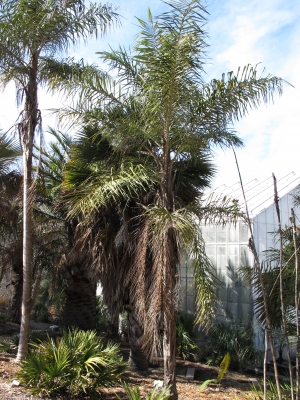Ceroxylon parvum
Galeano
Arecaceae
Common Name:
General Information
Ceroxylon parvum is a single-stemmed, evergreen palm growing from 2.5 - 10 metres tall. The unbranched stem can be 9 - 17cm in diameter; It is covered in a very thin layer of wax; and topped with a crown of 11 - 20 long, arching, horizontal leaves[
768- Title
- Field Guide to the Palms of the Americas
- Publication
-
- Author
- Henderson A.; Galeano G.; Bernal R.
- Publisher
- Princeton University Press; Princeton, New Jersey.
- Year
- 1995
- ISBN
- 0-691-08537-4
- Description
- An excellent book, giving basic information on all the 550 species of palms native to the Americas that were known in 1995. Comprehensive information on the plants range and habitat, brief description, some uses and almost 250 photos.
].
The plant is sometimes harvested from the wild for local use as a source of wood and thatch.
Known Hazards
None known
Botanical References
768- Title
- Field Guide to the Palms of the Americas
- Publication
-
- Author
- Henderson A.; Galeano G.; Bernal R.
- Publisher
- Princeton University Press; Princeton, New Jersey.
- Year
- 1995
- ISBN
- 0-691-08537-4
- Description
- An excellent book, giving basic information on all the 550 species of palms native to the Americas that were known in 1995. Comprehensive information on the plants range and habitat, brief description, some uses and almost 250 photos.
Range
S. America - Ecuador.
Habitat
Montane rain forest, forest remnants and open pastures; found at elevations from 1,400 - 1,780[
768- Title
- Field Guide to the Palms of the Americas
- Publication
-
- Author
- Henderson A.; Galeano G.; Bernal R.
- Publisher
- Princeton University Press; Princeton, New Jersey.
- Year
- 1995
- ISBN
- 0-691-08537-4
- Description
- An excellent book, giving basic information on all the 550 species of palms native to the Americas that were known in 1995. Comprehensive information on the plants range and habitat, brief description, some uses and almost 250 photos.
].
Properties
| Other Uses Rating |      |
| Habit | Evergreen Tree |
| Height | 6.00 m |
| Self-fertile | No |
| Cultivation Status | Wild |
Cultivation Details
A dioecious species, both male and female forms need to be grown if fruit and seed are required[
768- Title
- Field Guide to the Palms of the Americas
- Publication
-
- Author
- Henderson A.; Galeano G.; Bernal R.
- Publisher
- Princeton University Press; Princeton, New Jersey.
- Year
- 1995
- ISBN
- 0-691-08537-4
- Description
- An excellent book, giving basic information on all the 550 species of palms native to the Americas that were known in 1995. Comprehensive information on the plants range and habitat, brief description, some uses and almost 250 photos.
].
Edible Uses
None known
Medicinal
None known
Other Uses
The leaves are used for thatching[
768- Title
- Field Guide to the Palms of the Americas
- Publication
-
- Author
- Henderson A.; Galeano G.; Bernal R.
- Publisher
- Princeton University Press; Princeton, New Jersey.
- Year
- 1995
- ISBN
- 0-691-08537-4
- Description
- An excellent book, giving basic information on all the 550 species of palms native to the Americas that were known in 1995. Comprehensive information on the plants range and habitat, brief description, some uses and almost 250 photos.
].
The stems are used for house construction[
768- Title
- Field Guide to the Palms of the Americas
- Publication
-
- Author
- Henderson A.; Galeano G.; Bernal R.
- Publisher
- Princeton University Press; Princeton, New Jersey.
- Year
- 1995
- ISBN
- 0-691-08537-4
- Description
- An excellent book, giving basic information on all the 550 species of palms native to the Americas that were known in 1995. Comprehensive information on the plants range and habitat, brief description, some uses and almost 250 photos.
].
Propagation
Seed -
If you have any useful information about this plant, please leave a comment. Comments have to be approved before they are shown here.





 Useful Tropical Plants Database 2014 by
Ken Fern,
web interface by
Ajna Fern
with help from
Richard Morris.
Useful Tropical Plants Database 2014 by
Ken Fern,
web interface by
Ajna Fern
with help from
Richard Morris.